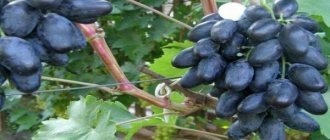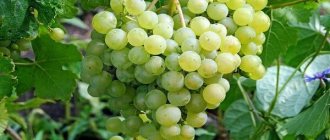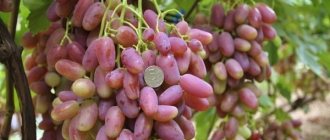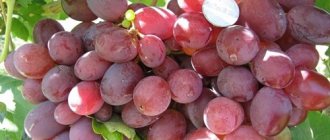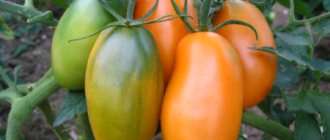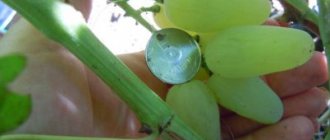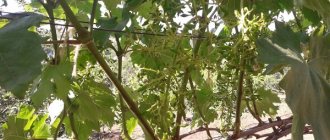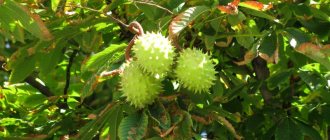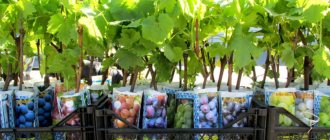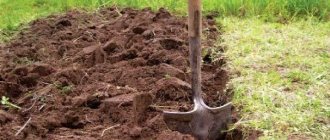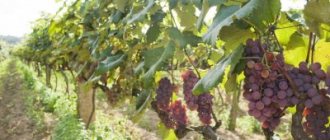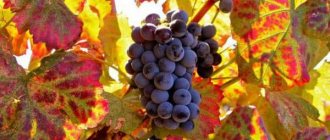Advantages and disadvantages
The main disadvantage is that it does not tolerate temperature changes well and can die at temperatures below -23 °C.
Variety Julian is not susceptible to peas
There are many more advantages:
- Good survival rate.
- High yield.
- Quick adaptation to new conditions.
- Super early maturing.
- Not afraid of hot weather and drought.
- Resistant to diseases and pests.
- Good taste characteristics.
- Signal brushes appear from the second year of life.
- High keeping quality.
Characteristics
Julian's cuttings take root quickly, take root well, and are suitable for many rootstock varieties.
Description of Arcadia grapes
Ripens very early - in early August (95-100 days pass from the beginning of flowering to full ripeness).
The grapevine can withstand frosts down to -24 °C, but requires shelter in winter. Julian tolerates drought well. It can be grown in regions with unfavorable climates.
He is not afraid of fungal diseases such as mildew and oidium. If the summer weather is favorable, it does not need to be treated with chemical fertilizers. In stormy summers or during an epidemic, it is better to carry out preventive spraying with preparations to protect the leaves and fruits.
In the southern regions it can be grown in open ground. It does not need protection from frost and winters well on supports. In the middle zone and more northern regions it can grow only in greenhouse conditions.
On a note! Julian is not afraid of wasps: the flesh is reliably protected by a dense skin that is not susceptible to harmful insects.
History of creation
This variety of crop was obtained in 2005 as a result of combinative selection carried out by V. U. Kapelyushny in collaboration with specialists from the All-Russian Research Institute of Viticulture and Winemaking named after. Ya. I. Potapenko.” Some sources indicate that during breeding, the Uzbek table grape variety “Rizamat” and the hybrid form “Kesha” (“Improved Delight”) were used for crossing.
Grape varieties that served as parent forms: “Rizamat” (left) and “Kesha” (right)
The vineyard of Vasily Ulyanovich Kapelyushny is located near the city of Aksai (Rostov region). Over the 30-year practice of growing the crop, the national breeder has carried out dozens of crosses of various varieties and hybrid forms, developed many new promising varieties, the most famous of which are: “Nadezhda Aksayskaya”, “Tatyana’s Dream”, “Ataman Pavlyuk”, “Aksai Manicure”, “ Rumba", "Debut" and others.
Since 2010, the variety has been tested both in commercial plantings and in amateur farms in the Anapo-Taman, Foothill and Central zones of Kuban, as well as on the Don, in the steppe and forest-steppe regions of Ukraine.
“Julian” has not received official registration in the State Register of the Russian Federation, and there is also no reliable data on its licensing and certification in foreign sources. Favorably differing in taste and marketability of fruits, these grapes did not leave amateur gardeners indifferent. It is grown in many regions of Central Russia, Northwestern, Central, Volga-Vyatka and Middle Volga regions, as well as in Ukraine, Belarus and other post-Soviet countries. You can get acquainted with its features in more detail from the video filmed by a Ukrainian amateur winegrower:
Comparison with similar varieties
The table provides a brief description of the varieties for comparison:
| Characteristics | Julian | Helios | Anniversary of Novocherkassk | Transfiguration |
| Ripening time | 100 days | 110 days | 115-120 days | 115 days |
| Productivity | 30-60 kg | 6-10 kg | 20 kg | 20 kg |
| Frost resistance | Up to -23 °C | Up to -23 °C | Up to -23 °C | Up to -23 °C |
| Disease resistance | High | Above average | Above average | Average |
| Bunches | 0.7-1.5 kg | 0.8-1.2 kg | 0.7-3 kg | 0.7-1 kg |
| Color | Light pink, with a yellowish tint | Pink | Pink with white and yellow shades | Pink |
| Taste | Sweet with strawberry and nutmeg aftertaste | Muscat | Harmonious | Harmonious |
| Sugar content | 28 % | 22 % | 16,5 % | 19 % |
| Acidity | 4-5 g/l | 6-8 g/l | 6 g/l | 7 g/l |
| Shelf life | 1-2 months | 1-2 months | 1 month | 1 month |
Reviews
Anna, Krasnodar My Julian bore fruit once. The shoots are strong, grow quickly, there were 2-3 inflorescences on each, normalized. The berries in the clusters are even, there are no peas. But the ripening time is longer than the stated 95-100 days.
Evgenia, Rostov region All of our Julian bushes are our own. It has great growth vigor and is disease resistant. The berries are dense, crispy, very sweet, if they hang longer - like honey. The brushes reach a length of 40 cm.
Gennady, Novgorod region Julian's berries are large, have a harmonious taste, the skin is not felt, the flesh is dense and crunchy. I myself planted it in a greenhouse just last year, the growth force is very powerful - I constantly shorten three thick vines so that they do not exceed 4 m, plus the length of the stepsons is up to 1.5 m. It produces clusters on stepsons of 1, 2 and 3 orders.
How to plant correctly
For successful rooting and adaptation of Julian grapes to the proposed climatic conditions, before planting the crop, select a site in advance, prepare the soil, and purchase suitable seedlings. To prevent the bushes from interfering with each other, adhere to the planting scheme.
Site selection and preparation
The place for the vineyard is chosen unshaded, well lit throughout the day. To protect the hybrid from drafts and northern winds, vines are planted along fences or buildings. Due to the powerful roots of the Julian grape, choosing a site with groundwater levels higher than 1.5 m is not allowed.
Preparing a site for crops begins with clearing, leveling, and digging. Julian develops correctly on well-drained light sandy loams, loams, and black soil. The grapes show high productivity, the fruits gain sugar content on sandy, rocky soils.
Acidic, salty and swampy soil is unsuitable for planting vines.
To alkalize the soil per 1 sq. m. add 0.5 kg of dolomite flour or a glass of lime.
If the site has heavy clay soil, sand, turf soil, and fine crushed stone are added to increase aeration. Sandy soils are diluted with humus and manure. When digging in 2 tiers, add 1 square meter to the black soil. m. 4 kg of organic matter, and in sandy infertile soils - up to 8 kg. Add 100 g of superphosphate to humus and manure.
How to select and prepare a seedling
Julian grape seedlings are purchased in garden centers, nurseries, and vineyards. Suitable planting material has at least 3-4 developed roots, a pronounced grafting site, a flexible vine, and living buds.
See also
Description and characteristics of Kesha grapes, planting and care
Read
Hybrid seedlings with dark, dry cuts on the roots, brittle shoots, and buds that fall out when pressed with fingers are discarded.
Before planting, the seedling is soaked overnight in water with the addition of honey or a root formation stimulant. The roots of the vine are cut to 15 cm and disinfected in a manganese solution.
Recommendations for choosing deadlines
Julian grapes are planted in the south in the fall until mid-October, in the central zone and to the north - in the spring, before the beginning of the growing season. Over the course of a season, the young vine takes root, gains strength, and goes into the winter prepared.
Planting scheme
If the area is fertilized, nothing needs to be added to the planting hole with a depth and a diameter of 0.8 m. A 10-centimeter drainage layer is made at the bottom from fragments of building materials and crushed stone, which is covered with a layer of soil.
If pre-planting preparation has not been carried out, a mixture of fertile soil, humus and mineral complex fertilizers is applied on top of the pit drainage.
Julian grape planting technology:
- a temporary support is installed at the bottom of the hole;
- dig in a metal or plastic pipe with a diameter of 5-7 cm for underground irrigation;
- moisten the pit generously with warm water;
- lower the seedling, straighten the roots, avoiding creases;
- cover the grape bush with substrate;
- compact the soil;
- re-water and mulch.
When planting, they retreat from the fence and from neighboring seedlings by 2-2.5 m.
Adviсe
Tip 1
To extend the shelf life of grapes, they need to be picked with gloves so as not to touch the berries with your hands and not damage the waxy coating. Cut the bunches with scissors. Harvesting should be done in cloudy, dry weather. Place paper in the container where it will be stored and place the bunches with the stalks facing up. Put the boxes in the cellar. Storage temperature – 2-4 degrees, humidity – 80%.
Tip 2
For planting, it is better to buy one- or two-year-old seedlings with well-developed roots. They must be purchased immediately before planting. The roots should not dry out during transportation. To do this, they need to be wrapped in damp burlap and placed in a plastic bag.
Tip 3
When covering the vines for the winter, you need to leave gaps for ventilation to prevent the grapes from overheating.
Rules of care
Compliance with the rules of agricultural technology affects the health and fruiting of Julian grapes. Crop care includes irrigation, fertilization, pruning, and processing.
Watering
For the first time, Julian is watered with warm water in early spring during a winter with little snow to give impetus to the beginning of the growing season. If there is enough precipitation in winter, irrigation is not carried out.
Irrigation in summer is important for the formation of ovaries and the filling of hybrid fruits.
Young grapes of the first year of life and mature bushes in the heat, in the absence of rain, are watered weekly in a volume of 10-20 liters for each plant.
To prevent cracking of the soil and freezing of the roots when preparing for winter, the soil is moistened at the rate of 6 buckets per 1 square meter. m.
It is not recommended to water grapes during flowering and 2 weeks before the fruits ripen.
Mulching
To reduce the intensity of irrigation, reduce the number of weedings and for additional nutrition of the root system, the hybrid is mulched with straw, freshly cut grass, and chicken droppings.
Coniferous sawdust and peat increase the acidity of the soil, which adversely affects the development of the vine.
To avoid acidification of the soil, the soil under the bushes is mulched for the first time after warming up to +12 °C.
Top dressing
In early spring, before removing the cover, a solution of a mineral complex is applied under the Julian grape bush. 5 g of potassium, 10 g of ammonium nitrate, 20 g of superphosphate are dissolved in a bucket of water.
A similar fertilizing of the crop is carried out before the Julian flowers bloom.
The hybrid reacts negatively to a lack of magnesium, therefore, during the growing season, before the fruits are colored, the vine is sprayed with a solution of magnesium sulfate (250 g per 10 liters of water) every 2 weeks.
For successful wintering of bushes in the fall, when loosening the soil, add ash, mulch the soil with humus and compost.
Formation
In the first year in the fall, the Julian grape vine is covered before wintering without pruning the vine. The next year, on last year's vine, called a shoulder and laid horizontally on a trellis, three shoots (sleeves) are left at a distance of 80 cm from each other.
In autumn, the sleeves are shortened by 8-10 buds and, together with the shoulder, are laid down for the winter.
In the spring of the third year, clusters form on the fruit links of the grapes growing from the sleeves. The buds that appear on the shoulder and below the wire of the first row of trellis are removed. Fruit-bearing vines are pruned in the fall.
In winter, the bush leaves with a shoulder and double sleeves, each of which consists of shoots from last year and the current year. After pruning the vine, there should be 40-45 eyes left on the Julian grape bush.
Preventive spraying
Before the buds open in the spring, the hybrid and the trunk circle are treated with Bordeaux mixture or copper sulfate.
After 2 weeks, the grape bushes are sprayed with Nitrofen (200 g per 10 liters of water), 14 days before flowering, Julian is dusted with colloidal sulfur from oidium.
To prevent infection of grapes with fungal spores, the bushes are treated again at the beginning of fruiting with Quadris and Topaz. Before sheltering for the winter, the vine is sprayed with iron sulfate.
Protection from wasps and birds
To protect the Julian grape harvest from birds, they use means that are divided into 2 categories - those that make it difficult to access the berries and those that repel them.
The first includes a protective net used to fence off the vineyard, wrapping paper, and gauze bags attached to the bunches.
To scare birds away from the fruits of the hybrid, CD discs and plastic bags cut into strips are hung on trellises. Balloons with painted eyes are attached to the top row of trellis wire. You can place a scarecrow nearby, but the birds quickly get used to it.
To prevent wasps from attacking the crop, the bunches are inspected for rot, and spoiled berries are removed. To divert the attention of insects from sweet berries, baits made of plastic bottles filled with sweetened water are placed in the vineyard.
Preparing for winter
After harvesting, the grapes are removed from the supports so that the vines bend to the ground. Before frost, the vines are tied together and placed on boards or cardboard. Julian is covered with burlap, spruce branches, and slate and linoleum are laid on top. After a snowfall, a snowdrift is thrown over the structure.
